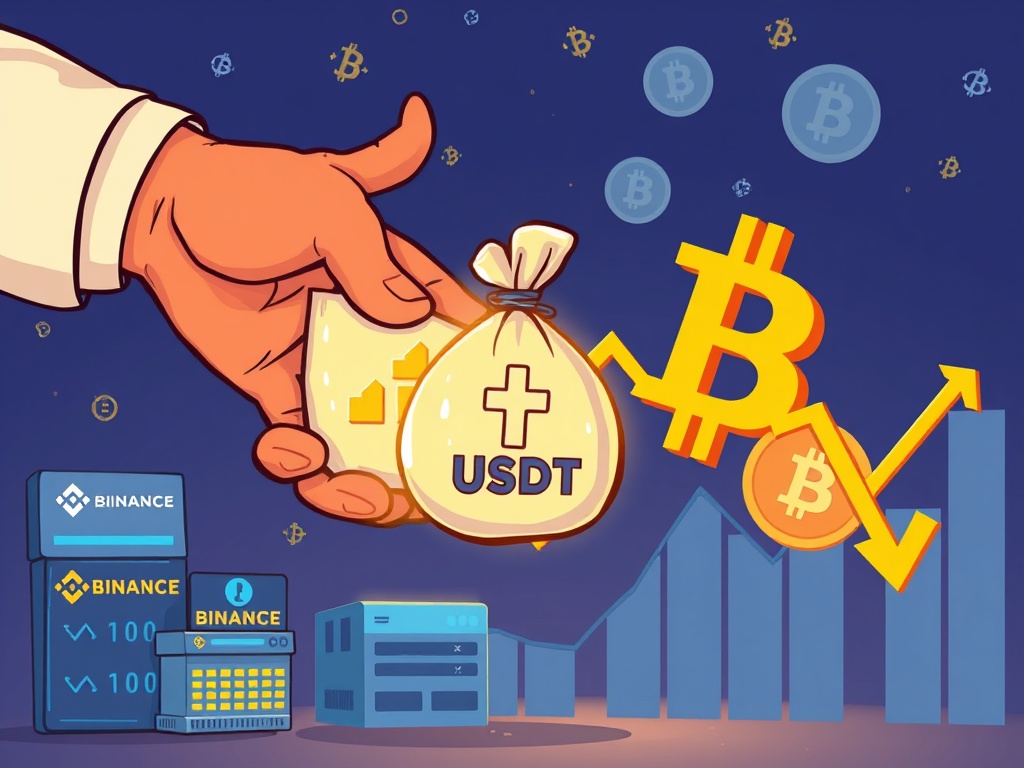BitcoinWorld

Galaxy Digital Withdrawal: Unveiling Crucial Moves Amidst Bitcoin’s Sell-Off
The cryptocurrency market is a dynamic landscape, often characterized by rapid shifts and intriguing maneuvers by major players. Recently, the crypto world has been abuzz with news surrounding a significant Galaxy Digital withdrawal. This event, involving hundreds of millions in USDT, has naturally sparked intense discussion and speculation, especially as it unfolds against the backdrop of a continued Bitcoin (BTC) sell-off. What exactly does this move signify for the market, and what can we learn from the actions of institutional giants like Galaxy Digital?
What Triggered This Crucial Galaxy Digital Withdrawal?
Earlier in the day, the crypto financial firm Galaxy Digital made headlines for depositing a substantial amount of Bitcoin to various centralized exchanges. This action alone often raises eyebrows, as large deposits to exchanges can sometimes precede selling activity, increasing supply and potentially downward pressure on prices. However, the plot thickened significantly just hours later.
According to diligent on-chain analyst @ai_9684xtpa on X, Galaxy Digital proceeded to withdraw a staggering $456 million in USDT (Tether) from three major exchanges: Binance, Bybit, and OKX, all within a tight 30-minute window. This rapid sequence of events – depositing BTC and then withdrawing a massive sum of stablecoin – is not merely coincidental. It suggests a deliberate, strategic play by a sophisticated institutional entity.
For context, Galaxy Digital currently holds a significant 18,504 BTC, valued at approximately $2.13 billion. This substantial holding underscores their deep involvement in the Bitcoin ecosystem, making their every move a subject of intense scrutiny. The Galaxy Digital withdrawal of such a large USDT sum immediately raises questions about their intentions: Is it a preparation for future investments, a rebalancing of their portfolio, or something else entirely?
Decoding Galaxy Digital’s Strategy: Is This a Bitcoin Sell-Off Signal?
When a major player like Galaxy Digital makes a move of this magnitude, it rarely happens without strategic intent. The Galaxy Digital withdrawal of $456 million in USDT, especially after depositing BTC, could be interpreted in several ways, each with different implications for the ongoing Bitcoin sell-off:
- Preparing for Dip Buying: One common strategy during a sell-off is to accumulate stablecoins to be ready to buy assets at lower prices. By withdrawing USDT, Galaxy Digital might be positioning itself to acquire more BTC or other cryptocurrencies if prices continue to drop, viewing the current downturn as a buying opportunity.
- Operational Liquidity: Large firms require substantial liquidity for various operations, including investments, partnerships, or even covering short-term liabilities. The USDT withdrawal could simply be a move to consolidate funds for immediate use outside of exchange trading, rather than a direct market signal.
- Hedging or Risk Management: In volatile markets, firms often engage in hedging strategies to protect their existing holdings. While less common to withdraw stablecoins for this, it could be part of a broader, complex financial maneuver to mitigate risk associated with their Bitcoin exposure.
- Market Sentiment Signal: Regardless of their direct intent, such a large Galaxy Digital withdrawal inherently sends a signal. Some might interpret it as a lack of immediate confidence in the market’s upward trajectory, prompting them to hold stable assets rather than volatile ones. However, it’s crucial not to jump to conclusions based on a single data point.
Understanding the full picture requires looking beyond just this one transaction and considering Galaxy Digital’s overall financial health and market outlook.
The Broader Bitcoin Sell-Off: What’s Driving the Market Downturn?
The Galaxy Digital withdrawal takes place within a broader context of a sustained Bitcoin sell-off. While specific institutional actions contribute to market sentiment, several macroeconomic and industry-specific factors are typically at play during such downturns:
Key Drivers of the Current Bitcoin Sell-Off:
- Macroeconomic Headwinds: Global economic uncertainties, including persistent inflation, rising interest rates, and geopolitical tensions, often lead investors to pull out of riskier assets like cryptocurrencies and seek safer havens.
- Regulatory Uncertainty: The lack of clear, consistent global cryptocurrency regulations continues to be a significant concern for institutional investors. Ambiguity can deter new capital inflows and encourage existing players to de-risk.
- Profit-Taking: After periods of significant price appreciation, some long-term holders and miners might decide to take profits, leading to increased selling pressure. This is a natural cycle in any asset market.
- Liquidations: In highly leveraged markets, even small price drops can trigger cascading liquidations, forcing traders to sell their assets to cover margin calls, thereby exacerbating the sell-off.
- FUD (Fear, Uncertainty, Doubt): Negative news, rumors, or even large, unexplained transactions like the Galaxy Digital withdrawal can contribute to a climate of fear, prompting retail investors to panic sell.
It’s a confluence of these factors that creates a challenging environment for Bitcoin and the broader crypto market, making every significant transaction by a firm like Galaxy Digital even more impactful on public perception.
Navigating Volatility: Actionable Insights for Investors Amidst a Galaxy Digital Withdrawal
For individual investors, navigating a volatile market, especially when large institutional moves like the Galaxy Digital withdrawal occur, can be daunting. Here are some actionable insights to consider:
1. Do Your Own Research (DYOR): While on-chain data and analyst reports are valuable, always verify information and understand the context. Don’t base investment decisions solely on single events or sensational headlines.
2. Understand Risk Management:
- Diversification: Don’t put all your eggs in one basket. Spread your investments across different assets to mitigate risk.
- Position Sizing: Only invest what you can afford to lose. Avoid over-leveraging.
- Stop-Loss Orders: Consider using stop-loss orders to limit potential losses during sharp market downturns.
3. Adopt a Long-Term Perspective: Cryptocurrency markets are known for their extreme volatility. Focusing on the long-term fundamentals of projects rather than short-term price fluctuations can help weather market storms.
4. Monitor On-Chain Data (with Caution): While intriguing, on-chain data requires expertise to interpret correctly. A large Galaxy Digital withdrawal, for example, could have multiple explanations. Use it as one piece of the puzzle, not the whole picture.
5. Avoid Emotional Decisions: Fear and greed are powerful drivers in crypto. Stick to your investment plan and avoid making impulsive decisions based on market FUD or FOMO (Fear of Missing Out).
The Power of On-Chain Analytics: Peeking Behind the Curtain of a Galaxy Digital Withdrawal
The ability to track large transactions, like the Galaxy Digital withdrawal, is a testament to the transparency of blockchain technology. On-chain analytics has become an indispensable tool for understanding market dynamics and institutional behavior.
On-chain analysts, like @ai_9684xtpa, meticulously monitor public blockchain ledgers to identify significant movements of assets between wallets, exchanges, and other entities. This provides a level of transparency that is often unmatched in traditional finance.
For instance, by observing a large deposit of BTC to exchanges followed by a massive USDT withdrawal, analysts can infer potential strategies. Is the firm preparing to sell BTC and hold stablecoins? Or are they accumulating stablecoins from a previous sale to deploy elsewhere? The beauty of on-chain data is that it provides the raw facts, though the interpretation still requires expertise and an understanding of market context.
While the exact motivations behind every large transaction remain proprietary, the visibility offered by on-chain data empowers the community to gain insights into the flows of capital, making events like the Galaxy Digital withdrawal visible to the public and fostering more informed discussions.
Conclusion
The recent Galaxy Digital withdrawal of $456 million in USDT, set against the backdrop of an ongoing Bitcoin sell-off, is a prime example of the complex and interconnected nature of the cryptocurrency market. While the exact strategic intent behind Galaxy Digital’s move remains speculative, it highlights the importance of institutional actions in shaping market sentiment and liquidity. Whether it signals preparation for future investments, operational rebalancing, or a more cautious stance, such large transactions underscore the dynamic interplay between major players and broader market trends. For investors, this event serves as a crucial reminder to stay informed, practice sound risk management, and avoid impulsive decisions in the face of market volatility.
Frequently Asked Questions (FAQs)
Q1: What is Galaxy Digital?
A1: Galaxy Digital is a diversified financial services and investment management company focused on the digital asset, cryptocurrency, and blockchain technology sectors. Founded by Mike Novogratz, it provides services such as asset management, trading, and advisory for institutional clients.
Q2: Why is a large USDT withdrawal by Galaxy Digital significant?
A2: A large Galaxy Digital withdrawal of stablecoins like USDT is significant because it indicates a major movement of capital by an institutional player. It can signal strategic rebalancing, preparation for future investments (like buying dips), or changes in liquidity management, all of which can influence market sentiment.
Q3: How does this Galaxy Digital withdrawal relate to a Bitcoin sell-off?
A3: The withdrawal occurred amid a continued Bitcoin sell-off, suggesting that Galaxy Digital’s move might be a response to or part of their strategy during this market downturn. It could be a way to accumulate stablecoin liquidity to potentially buy BTC at lower prices, or it might reflect a more cautious approach to the market’s current state.
Q4: Should I be worried about my Bitcoin holdings because of this news?
A4: While significant, a single transaction by an institution doesn’t necessarily dictate the entire market’s future. It’s crucial to understand the broader market context, your own risk tolerance, and investment goals. This event highlights market dynamics but shouldn’t be the sole reason for panic selling. Always do your own research.
Q5: What is on-chain analysis and how does it help understand events like this?
A5: On-chain analysis involves examining data directly from public blockchain ledgers to track transactions, wallet activity, and asset flows. It helps analysts identify large movements by entities like Galaxy Digital, providing transparency into institutional behavior and market liquidity, which can inform investment decisions.
If you found this article insightful, please share it with your network on social media to help others understand the complex dynamics of the crypto market!
To learn more about the latest crypto market trends, explore our article on key developments shaping Bitcoin’s institutional adoption.
This post Galaxy Digital Withdrawal: Unveiling Crucial Moves Amidst Bitcoin’s Sell-Off first appeared on BitcoinWorld and is written by Editorial Team





